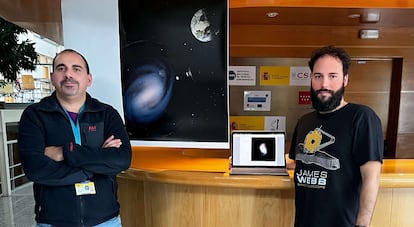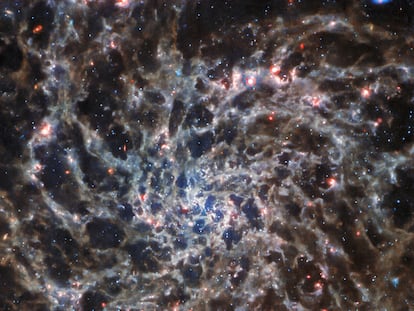Twin galaxy of the Milky Way discovered at the edge of the universe
A new study shows that similar galaxies existed 11.7 billion years ago, when the universe was barely 15% of its current age
Astrophysicist Luca Costantin went on vacation to the Spanish region of Cantabria last summer. On his first day off, August 1, after touring the beaches and green mountains of San Vicente de la Barquera, he turned on his laptop and got to work. “I have a bad habit of looking at my email for an hour before going to sleep, even on vacation,” he explains. In his inbox were new images taken by the revolutionary James Webb Space Telescope, launched on Christmas 2021. “I started looking at galaxies and classifying them, when one caught my attention,” he remembers. He had just discovered the galaxy ceers-2112, a kind of “twin sister” to the Milky Way — home to planet Earth — on the other side of space. The discovery was published on Wednesday in the prestigious science journal Nature.
The universe is about 13.8 billion years old. The study by Costantin and his colleagues reveals that galaxies similar to the Milky Way existed 11.7 billion years ago, when the universe was barely 15% of its current age. What the ultrasensitive James Webb Space Telescope had captured was the faint light sent then, in the infancy of the cosmos. “It’s like seeing our galaxy back in time,” says Costantin, a 33-year-old Italian researcher. Astrophysicist Pablo G. Pérez González compares the discovery to a 100-year-old person, who has never seen himself in the mirror, and receives a letter with a self-portrait that an unknown twin sister sent him when he was 15 years old. It is the most distant Milky Way-like galaxy known to science.
The galaxy ceers-2112 is observed in a region of the sky located between the constellations Ursa Major and Boyero, the dotted line that looks like a human figure and contains the star Arthur, one of the brightest in the sky. The stars of ceers-2112 have a total mass equivalent to 3.9 billion solar masses, dimensions that fit with the simulations of what the Milky Way was like at that time, according to Pérez González, another of the lead authors of the study. “At that time our galaxy had about 10 times less solar masses,” explains this researcher, who works alongside Costantin at the Astrobiology Center (INTA-CSIC), in the Madrid town of Torrejón de Ardoz.

The Milky Way, like other spiral galaxies in the nearby universe, has an elongated bar-shaped structure in its central region. The Hubble Space Telescope — launched in 1990 and primitive in comparison to the current James Webb — made it possible for researchers to study about 2,000 similar galaxies 15 years ago. NASA astronomers then concluded that central bars were a final episode in the evolution of spiral galaxies, as they formed when the orbits of stars become unstable and deviate from their previous circular path. In these bars, large amounts of gases build up, and new stars form, transforming galaxies.
The young ceers-2112, which was only 2.1 billion years old when it emitted the light that reached the telescope, surprisingly has a bar in its center. Pablo G. Pérez González explains the relevance of these elongated structures. “They are tremendously important, for example, for life. For the Sun to form with its metals, in the area where we are, and a planet to form around it with a lot of iron, a lot of nickel and also carbon, silicon and all the ingredients of life, there had to have been previous stars with such elliptical orbits, transporting material from where more stars form in a galaxy to the outer zones,” says the researcher.
Three years ago, the existence of another “twin” galaxy of the Milky Way, SPT0418-47, was announced. This galaxy was a gigantic and stable object when the cosmos was only 1.4 billion years old. However, that galaxy had no bar. “The Milky Way can have an infinite number of twins, and we observe each one at a different age of the universe. With the twins, we would like to understand the history of the evolution of the Milky Way,” says Pérez González. The galaxy ceers-2112 is named after the international project Cosmic Evolution Early Release Science, which includes astrophysicists from the Center for Astrobiology.
Mexican astrophysicist Yetli Rosas Guevara has applauded the new study, in which she did not participate. “It is the first publication that finds in the childhood of the universe these spiral galaxies that have a disk with a central bar. At that early age we would expect everything to be more turbulent,” explains the researcher, who works with cosmological simulations at the Donostia International Physics Center, in San Sebastián, Spain. Rosas Guevara emphasizes that the powerful James Webb Space Telescope has revolutionized astronomy, by allowing the first galaxies that formed in the universe to be detected. With more observations, she says, it will be possible to find out if ceers-2112 was an exception in the infancy of the universe or if there were many twin sisters of the Milky Way in existence.
Sign up for our weekly newsletter to get more English-language news coverage from EL PAÍS USA Edition
Tu suscripción se está usando en otro dispositivo
¿Quieres añadir otro usuario a tu suscripción?
Si continúas leyendo en este dispositivo, no se podrá leer en el otro.
FlechaTu suscripción se está usando en otro dispositivo y solo puedes acceder a EL PAÍS desde un dispositivo a la vez.
Si quieres compartir tu cuenta, cambia tu suscripción a la modalidad Premium, así podrás añadir otro usuario. Cada uno accederá con su propia cuenta de email, lo que os permitirá personalizar vuestra experiencia en EL PAÍS.
¿Tienes una suscripción de empresa? Accede aquí para contratar más cuentas.
En el caso de no saber quién está usando tu cuenta, te recomendamos cambiar tu contraseña aquí.
Si decides continuar compartiendo tu cuenta, este mensaje se mostrará en tu dispositivo y en el de la otra persona que está usando tu cuenta de forma indefinida, afectando a tu experiencia de lectura. Puedes consultar aquí los términos y condiciones de la suscripción digital.
More information
Archived In
Últimas noticias
All the effects of gentrification in one corner of Mexico’s Colonia Roma
Palestinian reporter Youmna El Sayed: ‘My family told me I had to choose between being a journalist or a mother’
The new language of the workplace: Knowing how to ask AI questions is more important than using it
Russell Tovey: ‘I was advised many times not to come out, I don’t think there was many people who’d done that — and I feel really proud that I’m one of those that did’
Most viewed
- The low-cost creative revolution: How technology is making art accessible to everyone
- Christian Louboutin: ‘Young people don’t want to be like their parents. And if their parents wear sneakers, they’re going to look for something else’
- US sanctions against jailed cartel leader ‘El Marro’ highlight Mexico’s lack of control over its prisons
- Liset Menéndez de la Prida, neuroscientist: ‘It’s not normal to constantly seek pleasure; it’s important to be bored, to be calm’
- ‘El Limones’ and the growing union disguise of Mexican organized crime











































